
Wine Culture and Information since 2002 - Volume 22
 Wine Culture and Information since 2002 - Volume 22 |
|
Issue 44, September 2006 |
Contents |
|
|
Wine Made with Wood Chips? No, Thank You! |
|
Fashions were not enough to make the world of wine uniform and homologated. Fashions were not enough to debase even more the image of wine and to sacrifice, one more time, a unique product, expression of a millenary culture. The latest news is that now the law is working for the same goal, too. This way we will be happy to have in our glasses a wine made with methods not agreed by many, however perfectly legal, as upon the heads of us mortals the wisdom of a law could decide for all of us a new model of wine making. The European Union - proposed by the Management Committee for Wine in Brussels - is evaluating the possibility of using wood chips for the wines produced in the community. Within few months, the European Union could in fact allow viticulturists of the Union to use oak wood chips for the production of wines, just like the way it is already permitted in the countries of the so called “New World”, a measure that, frankly speaking, leaves speechless and very perplexed. It is the latest menace to the world of wine to the exclusive advantage of the usual “smart ones”, who will finally have a perfectly legal way to sell consumers the illusion of tasting a wine aged in wood casks. There are many “justifications” proposed by the ones who support this new law, most of them, honestly speaking, are pretty arguable. Without discussing about the reasons of these opinions, which are to be taken for what they are, it should be however understood the role of the cask in wine making and whether it can be replaced by “wood chips”. Despite for most of consumers it is true the organoleptic sensation typical in wines aged in cask gives the conviction in the glasses has been poured an “important” wine, every real wine lover which can be called like that, knows cask is more than that. First of all, the beneficial effect of the slow oxidation the wine has in the cask and which is impossible to get with any chip. Perhaps it is thanks to the common “ignorance” wood chips get their main support: in case wood aroma and taste are perceived, therefore the wine is undoubtedly good, important and of quality. This “trick” can be done by using wood chips, whose cost - among the other things - is far lesser than the worst of casks. One of the reasons supporting this law is in fact represented by costs. The possibility of using wood chips in the production of wines should help - they say - to contrast the strong attack to the European market done by the wines coming from those countries in which the use of this technique is permitted. As the wine produced with wood chips undoubtedly has a lower price, as well as considering the fact consumers like “important” wines having wood taste, in this way it will be possible to release in the market the so called “carpenter's wines”, to the advantage of wallets and the palate of the most unwary consumers. Let's admit this, the price of wine has reached pretty prohibitive levels and accessible only by few, where most of the times speculation takes the place of an arguable and presumed quality. Did they really need to take such a measure, which certainly humiliates the dignity both of consumers and wine, in order to make a mass of consumers happy, which, again, are completely ignorant about what the market is proposing? Consumers will be hoaxed twice, both for the fact wine produced in this way will have no obligation to write in the label this disputable technique, as well as for the lacking of honesty from producers who will make wood chips their best ally in the cellar. We understand the fact not all consumers are interested in looking for or appreciating quality in the beverage of Bacchus, after all, not all the people can appreciate art or can feel the emotions of a painting. However they should grant us the freedom, or better to say, the awareness of choosing, by clearly writing in the label the type of wine contained in the bottle. If there are consumers who prefer wines made with wood chips, they have all the rights to buy it and to appreciate it, we however think it is not fair this measure can be a subtle way to hoax everyone. Although it is true only the wine maker exactly knows all the miracles happening in his or her cellar - thanks to chemistry and to its magic, most of the times it is possible to make a bad wine into something “decent” - we do not believe they should take advantage of technology in order to sacrifice honesty. In many countries, for example, it is mandatory to write in the label whether the wine contains sulfites, likewise they should clearly write in the labels the use of wood chips and not ridiculous description praising its wood aroma or taste, in order to make that wine into something it is not, and for the sake of speculation. To make the situation even worse, there were many who expressed their opinions - a ridiculous way to make a stone appear as if it were gold - who believe the use of wood chips is an “alternative” way to age wines. The ones supporting these opinions should, in our opinion, better understand the complex chemical and physical phenomena taking place in a wine kept in a cask to age, something which cannot be obtained in any case with wood chips. It would be better, as well as honest, to simply define these wines for what they really are: wood aromatized wines. This would be correctness and honesty! Certainly not an alternative way to “age” wines! After all, in what consists the technique of using wood chips in a wine? To put a wine in an inert tank - usually stainless steel - to plunge a bag full of wood chips and to allow it to macerate for some time. Does this mean aging a wine? Does this mean making a wine more “important”? Although we have nothing against aromatized wines, we believe wines produced with wood chips should necessarily belong to the category of aromatized wines, something which should also be written in the label. We are not saying we are against the use of this technique - after all if there are consumers who like wood aromatized wines and are happy with their consumption, everyone is free in his or her choices - we simply want honesty and correctness, not only for consumers in general, but also for the dignity of wine and its culture. A law like that, no matter how it will be, leaves perplexed. Not only for the not very honest way to support it, by making it look like something it is not and will never be, but also for the consequences in the efforts done so far in the promotion of quality wine and its typicality. Going on like this, bureaucrats will soon or later make a law defining grape varieties to use in the production of wine, while banning all the autochthonous ones, of course. They will do that, there is no doubt about this, for the safeguarding of the interests of consumers - not for the interests of the usual “smart ones”, of course - and for increasing the prestige and the quality of wine, of typical products and their diversities. It is so evident…
|
||||
MailBox |
|
In this column are published our reader's mail. If you have any comment or any
question or just want to express your opinion about wine, send your letters to
our editorial or fill in
the form available at
our site.
|
| It is said the use of chemistry in modern wine making is frequent and most of the time indispensable. How could they make wine in the past without the help of chemistry? |
| Fabio Mussi -- Milan (Italy) |
| In its essential definition, wine is the result of the alcoholic fermentation of must, a process that, in its nature, is to be considered of chemical type. For this reason, enology and chemistry have a strong and indissoluble bond: wine is the product of a chemical reaction. It is known chemistry is not used in enology for the “simple” production of wine only, it is also and above all used for the stabilization and correction of this beverage. It is no secret that thanks to chemical corrections it is possible to make a bad wine into something decent - or however less worse than what it is - by adding lacking substances or filtering excessive ones. There are many chemical substances used in enology for the production of wines, including the famous and “debated” sulfur dioxide, useful for stabilizing wines. However sulfur dioxide is only one of the many chemical substances permitted in the production of wines, whose usage could be in many cases limited, however it should be observed some substances are added to wine in order to make it more marketable and to meet consumers' expectations. One of these substances is gum arabic, capable - like in a miracle - to make smooth and agreeable any wine while increasing structure as well: one of the many magic which can be done in the cellar thanks to chemistry. |
| Why are most of red wines produced by assembling Cabernet Sauvignon and Merlot? |
| Thomas Peterson -- Baltimore, Maryland (USA) |
| The combination of Cabernet Sauvignon and Merlot is for wine producers one of the most common choices. Not only the two grapes are used alone for the production of mono varietal wines, they are also added in variable percentages to other grapes. The magic combination of Cabernet Sauvignon and Merlot originated from Bordeaux - their homeland - which together with Cabernet Franc, they make the so called Bordelais blending. Bordeaux wines are famous worldwide, this is not a mystery. For this reason, the combination Cabernet Sauvignon and Merlot has been widely used in order to emulate Bordeaux wines and to take advantage of their success. The second reason is that wine produced with these two grapes are generally appreciated by most of consumers, in particular the wines in which Merlot is present. There is no doubt Cabernet Sauvignon and Merlot are grapes capable of making great wines: tens of examples in the world are ready to confirm the quality of these two grapes. However, something which is frequently forgotten is that two grapes, famous or unknown, are not enough to make a good wine: grapes - which first of all must be cultivated and vinified with quality criteria - represent only one of the many factors needed for the production of great wines. |
ChablisUsually defined as the Chardonnay coming from the cold, Chablis wine has been for years the reference model for the production of wines with this famous white grape |
|
The enological events in Chablis have been pretty singular. Being for many years the undisputed model for wines produced with Chardonnay, its name has been in the world the synonym of white wine and, in particular, of Chardonnay. Its notoriety and its influence have been such that some producers outside France have used the name Chablis for their wines, wines that with the famous French area had nothing in common, not even the Chardonnay grape. Bulwark of the production of white wines fermented and aged in steel tanks, in recent years Chablis had to face the strong attacks done by the wines produced with the barrique, in particular, the ones coming from the so called “New World”. Despite producers in Chablis had to adapt their wineries to the new trends - many of them have completely or partially abandoned steel tanks by replacing them with barriques - the wine production of this famous French area is still a reference point, thanks both to the particular environmental and climate conditions as well as to the techniques used for the production of wines. Despite it is very near to Champagne and the capital Paris, Chablis belongs to the Burgundy wine region. By considering climate, soil and environmental conditions, Chablis is in fact more similar to Champagne than to Burgundy, even though here - as it is commonly known - in wines there are no bubbles. Even without bubbles, Chablis wines do not pass unnoticed in the glasses of connoisseurs. Generally defined as the Chardonnay coming from the cold, Chablis wines are appreciated for their high acidity - sometimes even excessive - a quality which is hard to find in wines produced elsewhere with the smooth and round Chardonnay. Moreover, the choice of using inert containers - typically steel tanks - contributes to the keeping of Chardonnay's “fresh” qualities, as opposed to what usually happens in wines fermented and aged in cask, in which wood contributes to make Chardonnay round and velvety.
The wine history of Chablis begins with the arrival of ancient Romans during the colonization of the ancient territories of France in order to broaden the borders of their empire. As it is commonly known, ancient Romans were used to introduce the cultivation of vine - and therefore the production of wine - in every place they were successful in conquering: not only the introduction of a tradition of them, but also a necessity in order to always have wine to quench the thirst of their legionaries. Which grapes and which methods were used for the production of wine in Chablis at those times is one of the many mysteries lost in the past and which did not reach our times. According to the climate and environmental conditions of the area, it is very likely it was a wine produced with white berried grapes, however it is impossible to say it was Chardonnay. Moreover, there are no historical evidences about the grapes cultivated at those times in the Chablis area as well as no evidences about the grape varieties introduced by ancient Romans. The first written mention of Chablis is dated back to 510 AD. The cultivation of vine, and therefore the production of wine, had a strong development - here as elsewhere in Europe - thanks to the activity of monks belonging to different religious orders, in particular Cistercians who, it is very likely, introduced Chardonnay in Chablis. Many monasteries and churches were in fact built in this area, including a monastery built by Sigismund, the first Christian king of Burgundy, as well as the church of Saint Mary built by Charlemagne. After the invasion of Vikings, monks of Tours were forced to move to Auxerre, contributing to the development of Chablis wines. The choice of moving to Auxerre was not casual. The area offered good climate and environmental conditions for the cultivation of vine - and wine is an essential element for the celebration of liturgy - as well as the presence of a fluvial port which ensured an easy connection to Paris. It will in fact be thanks to the fluvial connection that Chablis wines will be transported in quantities to Paris and became one of the wines which were more easy to find in the capital. Some centuries later, Chablis wines passed the borders of France and reached England. In some registers dated back to the half of the fifteenth century, are in fact found mentions about Chablis wines transported in barrique to the region of Picardy, Flanders and England. This flourishing period for Chablis and its wines, was suddenly stopped in the first years of the 1600s, when the area was devastated by Huguenots who set the city on fire. Most of vineyards were therefore destroyed, whose reconstruction, not only of vineyards but also of the fame of Chablis, took almost two centuries. The reconquered prestige for Chablis wines did not last long: soon after other fearful enemies will come to devastate vineyards. The decline began in 1886, when in vineyards of Chablis appeared powdery mildew and just one year later arrived phylloxera as well. Two events which discouraged many viticulturists who for many years avoided planting vines in their lands, with negative consequences for wine production in Chablis. The arrive of railroad represented another factor which contributed to the loss of interest of viticulturists to the production of wine. Thanks to the railroad connection, wines from other French areas could reach the capital Paris in shorter times, therefore diminishing the presence of Chablis wine in the market. Wine production was also severely reduced because of the two world wars. In 1945, after the end of World War Two, production in Chablis lowered to a mere 481 hectoliters as opposed to the 15,000 of 1938. The decline of viticulture and wine making in Chablis continued until the half of the 1950s, when in the renowned land of white wines there were a little more than 200 hectares of vineyards. This was the darkest period of Chablis in the last decades, it however marked the beginning of its reprise and prestige. Today Chablis represents a worldwide reference point for Chardonnay wines, a model widely copied also outside the borders of France and which also originated, thanks to the fame of its name, wines produced in the countries of the “New World” commercialized with the Chablis name. A deplorable plagiarism, not only for the improper use of the name, but also for the many grapes used - most of the times unknown - for the production of wines of pretty ordinary quality.
|
||||||||||||
|
Chablis wine area is recognized by the French quality system as AOC (Appellation d'Origine Contrôlée, Appellation of Controlled Origin) and belongs to the Burgundy wine region. Chablis wines are produced with Chardonnay grape, therefore white, and the most common technique makes use of steel tanks, whereas barrique is not very common. Chablis wines are classified, from the lowest level to the highest, as: Petit Chablis, Chablis, Chablis Premier Cru and Chablis Grand Cru. As for production, the highest percentage - more than 80% - is destined to wines belonging to the categories Petit Chablis and Chablis. Despite there are 40 vineyards belonging to the Chablis Premier Cru appellation, only 12 of them are considered of major prestige: Beauroy, Côte de Léchet, Fourchaume, Les Fourneaux, Mélinots, Montée de Tonnerre, Montmains, Monts de Milieu, Vaillons, Vaucoupin, Vaudevay and Vosgros. The Chablis Grand Cru category is even smaller than that, counting seven vineyards (climat) only: Blanchot, Bougros, Les Clos, Grenouilles, Preuses, Valmur and Vaudésirs.
|
|
Chablis is the most northern wine area of Burgundy and it is located about 200 kilometers north-west (about 125 miles) from Côte d'Or. Paradoxically, Chablis is closer to Champagne than to the main area of burgundy: few tens of kilometers separate Chablis from the vineyards of Aube. Being close to Champagne has also represented, at the beginning of 1900s, when the AOC French quality system was not introduced yet, a connection between the two wine areas. It in fact happened the crisp Chardonnay wines from Chablis were transported to Reims and Epernay and transformed in noble champenois bubbles. If we consider the geographic position, the composition of soil and environmental conditions, Chablis is more similar to Champagne than to Burgundy. The soil of Chablis area is in fact rich in chalk - just like the one of Champagne - a quality which gives its wines their characteristic mineral and flint aromas and taste. With its ups and downs, moments of more or less noble prestigious times, Chablis wines have always been capable of catching the attention of the world. After having been for centuries the absolute protagonist of wine sold in Paris - Chablis has been for years the area from which the capital got the wine to be poured in carafes - and after having created a wine making model renowned worldwide in which the name of this area has been associated to Chardonnay, today Chablis wines suffer of the fact they did not obey to that wine making model, typical in the “New World”, where the barrique is the king of the cellar. Today Chablis whites probably are the less understood wines by most of consumers, because they are outside of the homologation of taste which invaded the world of Chardonnay, and its typical mineral organoleptic qualities of flint perhaps require too much attention if compared to the immediate approach of oak wood aromas and taste. Despite in past times Chablis was produced by using the traditional feuillette - a small wood barrel having the capacity of 132 liters - in the last decades it was the steel tank to be mainly used in the cellar. Moreover, the introduction of new important technologies, such as the fermentation at a controlled temperature, have contributed to relaunch Chablis wine worldwide, by creating a wine making model which is now one of the most imitated in the world. A model which is however facing the strong attacks of the new Chardonnays coming from the “New World”, that with their immediate and direct wood aromas have easily conquered the palates of many wine lovers. The new trend has also been cause of new debates among Chablis producers who were already involved in debating about the commercial and enological utility of their traditions and the new techniques. Many of them have however been tempted by this new fashion and adopted in their cellar the use of barrique both for the fermentation and the aging of Chardonnay. Chablis viticulture and enology have walked a triumphant way beginning from the half of the 1950s, when the acreage destined to vineyards was a mere 500 hectares (1,235 acres). In the first years of the 1970s the acreage reached 750 hectares (1,853 acres), while today the covered land by vineyards is 4,300 hectares (10,625 acres). The environmental condition of the area frequently makes viticulture a difficult enterprise. One of the main problems viticulturists have to face is in fact frosts, an event which can also happen in May. There are two methods used in Chablis against frosts. The first one consists in placing stoves in vineyards in order to heat the air, the second one consists in sprinkling water on the vine's sprouts which will be then frozen by cold, therefore creating a layer of ice which will protect buds. The severe meteorological conditions and the particular composition of the soil give Chablis wines that absolutely mineral and personal character, a crispness hardly found elsewhere, qualities which made famous the wine of this area as the Chardonnay coming from the cold. The production is mainly about wines destined to the Chablis AOC and Petit Chablis AOC appellations, usually produced from vineyards cultivated in the plains. Soils mainly made of chalk and fossil deposits are destined to the production of Chablis Premier Cru AOC and Chablis Grand Cru AOC wines, that is the two categories which made famous worldwide the enological production of this area with the typical mineral and flint organoleptic qualities. The seven climat Grand Cru are located near the north side of the city of Chablis, vineyards from which are being produced the most famous and looked for Chardonnays. Also Premier Crus are to be considered excellent wines, in which it is always possible to find the mineral qualities and the style of Chablis. Also in wines belonging to the Chablis AOC and Petit Chablis AOC categories it is not rare to find good surprises. In particular Petit Chablis, a wine to be consumed young - usually considered a wine to be consumed daily with meals - that in its simplicity can be a good starting point to understand the style of this famous French wine area.
|
Comparing SangioveseQueen of vineyards in central Italy, in its countless clonal varieties, Sangiovese is a grape not so easy to cultivate and to vinify, however capable of great wines |
|
Among the many autochthonous grapes cultivated in Italy, there is one, despite it is mainly common in central regions, which has made Italian enology known all over the world. It is Sangiovese, the protagonist of many famous wines - such as Brunello di Montalcino, Chianti and Vino Nobile di Montepulciano - the most common red berried grapes in Tuscany, Emilia Romagna and Umbria. Sangiovese is also cultivated in the vineyards of Latium, Marches, Abruzzo, Lombardy, Veneto, Campania, Molise, Apulia, Calabria, Sicily and Sardinia. Indeed, in some cases, Sangiovese is also used in Veneto for the production of the renowned Amarone. In the central regions of Italy, Sangiovese is used in the production of mono varietal wines as well as blended to other grapes, most of the times “international” ones. For example, the combination of Sangiovese with Cabernet Sauvignon and Merlot is common in Tuscany for the so called Supertuscan wines, a combination which is also found in the other regions of central Italy. Among the most ancient Italian grapes known - it seems ancient Etruscans used it for the production of wine - Sangiovese area of origin seems to be Tuscany, the region where it represents the most common red berried grape. Its name comes from the Latin Sanguis Jovis - that is blood of Jupiter - and with time it will become “Sangiovese”, passing for many variants, of which the most famous one is San Gioveto, still used in Tuscany. According to its nature, Sangiovese is a grape which can easily mutate, and today are known tens of different clonal varieties. The ampelographic classification divides this grape in two major categories: Sangiovese Piccolo, (Small Sangiovese) with small berries, and Sangiovese Grosso, (Big Sangiovese) with bigger berries and author of Brunello di Montalcino and Vino Nobile di Montepulciano. Because of the easy nature of Sangiovese to mutate, there are many ampelographers who support the necessity of a more accurate classification than the two categories traditionally recognized.
|
|
Sangiovese is a grape having an excellent capacity of adaptation in many soil types, one of the factors which contributed to its spreading all over central Italy. Despite of this, according to a viticultural point of view, Sangiovese is a pretty susceptible variety to the attacks of molds, in particular during cold, wet and rainy seasons. As it easily tend to give abundant yields, Sangiovese requires pretty rigorous viticultural practices in order to allow a quality production. According to an organoleptic point of view, Sangiovese basically makes wines with a pretty evident acidity that, together with its high contents in polyphenols, can result excessively harsh. For this reason, wines produced with Sangiovese are usually aged in cask in order to mitigate the strength of its tannins and to make the wine smoother and less aggressive. Another method used for making Sangiovese less aggressive is to blend it with other grapes, in particular Merlot and, traditionally, Canaiolo Nero.
The wines selected for our comparative tasting come from the three regions where Sangiovese represents the most cultivated red berried grape, three different ways to interpret this famous grape. Three wines expressing three different territories - Umbria, Tuscany and Emilia Romagna - all being aged in cask, a common and traditional practice for Sangiovese. The first wine selected for our comparative tasting is Colli Martani Sangiovese Riserva Properzio produced by the interesting Umbrian winery Di Filippo. The second wine is Val di Cornia Suvereto Sangiovese produced in Tuscany by Gualdo del Re. The last wine, coming from Emilia Romagna, is Sangiovese di Romagna Superiore Thea produced by Tre Monti. The three wines will be served at a temperature of 18° C (64° F) in order to favor the correct development of aromas, without compromising Sangiovese's acidity as well as the roundness given by cask. The comparative tasting will be done by using three ISO tasting glasses.
|
||||||||
|
Sangiovese is a grape with a pretty high contents in coloring substances, however the intensity of colors in its wines basically depends on how the grape was cultivated and the wine making practices. Despite its good coloring capacity, Sangiovese wines are characterized by ruby red colors of good intensity with an average transparency, in other words, it will hardly be noticed deep and intense colors, almost impenetrable to light, like the ones typical in some Cabernet Sauvignons. Thanks to the good content in acid substances and polyphenols, as well as alcohol volume, quality Sangiovese wines can also age for tens of years, a period during which the color evolves up to showing pretty brilliant brick red hues. Sangiovese's color tends to show garnet red nuances after some years of aging in bottle, and with time - because of the progressive sediment of polyphenols - transparency will increase as well, something which is easily observable in Sangiovese wines aged for a long time, such as Brunello di Montalcino and Vino Nobile di Montepulciano. The first wine of which we will examine appearance is Di Filippo's Colli Martani Sangiovese Riserva Properzio. We will begin by evaluating the intensity of color, by observing the liquid mass at the base of the glass: it will be noticed an intense ruby red color, pretty transparent. By tilting the glass over a white surface, it will be noticed - by observing the wine towards the opening of the glass - a ruby red nuance. Let's now examine the second wine, Tre Monti's Sangiovese di Romagna Superiore. Also in this wine it will be observed a pretty brilliant ruby red color and an average transparency, the same color will be observed in the nuances, after having tilted the glass. As opposed to the previous wines, Gualdo del Re's Val di Cornia Suvereto Sangiovese shows an evident low transparency, in which it is possible to observe a strong ruby red hue and nuances of the same color.
|
|
The olfactory evaluation of Sangiovese opens the doors to the a world mainly made of red fruits and flowers: this is what Sangiovese usually offers to its wines in terms of secondary aromas. As the most frequent vinification technique used for Sangiovese makes use of casks, wines produced with this grape will also express tertiary aromas. Among fruit aromas distinguishing Sangiovese, two in particular emerge from all the other ones, the aromas of black cherry and plum. Moreover, Sangiovese is characterized by another aroma, belonging to the world of flowers, expressed by the exuberance of violet. These three aromas, of course, are also frequent in wines produced with other grapes, however in Sangiovese this combination is usually pretty intense. Among other fruit aromas typical in Sangiovese, are mentioned raspberry, blueberry and, sometimes, strawberry, whereas as for flower aromas, besides violet, in Sangiovese can also be perceived aromas of red rose and cyclamen. The first wine of which we will evaluate aromas is Di Filippo's Colli Martani Sangiovese Riserva Properzio. We will begin by evaluating opening aromas. By holding the glass in vertical position and without swirling it, we will do the first smell which will allow the perception of black cherry, violet and plum, the three typical aromas of Sangiovese grape. After having swirled the glass in order to oxygenate the wine, we will proceed with the second smell. It will be possible to perceive the aromas of blueberry, carob and cyclamen, to which will follow a series of tertiary aromas, where it will be possible to recognize vanilla, licorice and tobacco, as well as hints of cinnamon. It should be noticed, in particular, the opening of Properzio is characterized by the typical aromas of Sangiovese which will also be found in the other wines. Let's now pass to the evaluation of the second wine, Tre Monti's Sangiovese di Romagna Superiore Thea. By holding the glass in vertical position, we will proceed with the evaluation of opening aromas. It will be perceived the typical aromas of plum and black cherry, to which will follow aromas of violet and rose, very intense and clean. After having swirled the glass, let's now proceed with the second smell. It will be perceived aromas of blackberry, cyclamen, lavender and tobacco followed by aromas of licorice, vanilla, cocoa and mace. Let's now pass to the olfactory evaluation of the last wine, Gualdo del Re's Val di Cornia Suvereto Sangiovese. Opening aromas will be characterized, also in this case, by black cherry, plum and violet, very intense and clean. After having swirled the glass, we will proceed with the second smell which will allow the perception of the aromas of blueberry and blackberry as well as vanilla, clove, chocolate, tobacco, pink pepper and a pleasing balsamic hint of menthol, the sign, just like the other tertiary aromas, of the passage in wood and of its level of its toasting.
|
||||
|
Among the main gustatory qualities of wines produced with Sangiovese we find acidity, that in this grape is pretty evident, however less evident than in other red grapes with strong acidity, such as Nebbiolo, Barbera and Pinot Noir. Another organoleptic quality typical in Sangiovese, at least in wines produced with quality criteria and low yields in vineyards, is a pronounced astringency caused by the content in polyphenols. The strength of tannins in Sangiovese is usually mitigated by the aging in cask, although it is pretty frequent the blending with other less astringent grapes, such as Merlot or Canaiolo Nero. The effects of the use of cask in Sangiovese wines is pretty evident also in the taste: the round character trying to mitigate wine's crispness is an easily recognizable quality. As for alcohol volume, wines produced with Sangiovese generally ranges from 12,5% to 14%, frequently an alcohol by volume of 13-13,5%, in order to better contribute to the “smooth” character of the wine while contrasting the “harsher” side. The first wine we will examine is Di Filippo's Colli Martani Sangiovese Riserva Properzio. The first sip will evidence an attack characterized by the astringency of polyphenols, and next it will be noticed the typical acidity of Sangiovese, everything is however balanced by the good roundness given by cask as well as by acidity. It should also be noticed the body of the wine, not really robust, however robust enough to be well noticed. Let's now pass to Tre Monti's Sangiovese di Romagna Superiore Thea: also the attack of this wine is characterized by an evident astringency followed by a good crispness, once again, well balanced both by alcohol and by the aging in cask. The attack of Gualdo del Re's Val di Cornia Suvereto Sangiovese shows a more robust structure as opposed to the previous wines, however having a dominant astringent quality balanced by the roundness given by the passage in wood that - together with alcohol - contribute to mitigate the effect of acidity as well. It should finally be noticed how in all the three wines can be perceived a very good correspondence to the nose of the dominant aromas of black cherry and plum.
|
|
The taste-olfactory persistence of the wines produced with Sangiovese grape is usually very good, although - as always - this characteristic essentially depends on the quality of cultural practices and wine making. The finish of Di Filippo's Colli Martani Sangiovese Riserva Properzio is persistent and it is possible to perceive intense flavors of black cherry and plum, the two most characteristic fruits in Sangiovese, to which will follow the flavor of blueberry. Also the finish of Tre Monti's Sangiovese di Romagna Superiore Thea is persistent and intense, with very clean flavors of black cherry and plum as well as a pleasing flavor of blackberry. The finish of the last wine, Gualdo del Re's Val di Cornia Suvereto Sangiovese, is persistent and - just like in previous wines - with very intense flavors of black cherry, plum and blueberry. Despite Sangiovese is a basically acid grape and with a pretty strong astringency, it should be noticed how in all the three wines the practice of aging in cask contributes to make the final result agreeable and round, and in some cases - also thanks to the effect of alcohol - it perfectly balances the acidity in a way the relative perception of its taste is very attenuated.
|
Wines of the Month |
|
|
|
Score legend Prices are to be considered as indicative. Prices may vary according to the country or the shop where wines are bought |
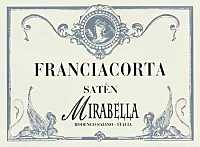
|
|
Franciacorta Satèn |
|
| Mirabella (Lombardy, Italy) | |
| Grapes: Chardonnay | |
| Price: € 12.50 | Score: |
| This Franciacorta shows a brilliant straw yellow color and nuances of greenish yellow, very transparent, fine and persistent perlage. The nose denotes intense, clean, pleasing and refined aromas that start with hints of bread crust, grapefruit and banana followed by aromas of acacia, yeast, hawthorn, apple, plum, mineral, hazelnut and hints of vanilla. The mouth has good correspondence to the nose, a crisp and effervescent attack, however balanced by alcohol, good body, intense flavors, agreeable. The finish is persistent with flavors of banana, apple and plum. Part of the base wine ages in barrique. This Franciacorta Satèn ages for at least 28 months in bottle on its lees. | |
| Food Match: Aperitifs, Fish and crustaceans appetizers, Pasta and risotto with fish and crustaceans | |
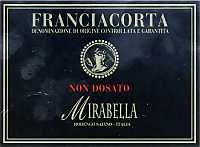
|
|
Franciacorta Pas Dosé 1998 |
|
| Mirabella (Lombardy, Italy) | |
| Grapes: Chardonnay (50%), Pinot Blanc (30%), Pinot Noir (20%) | |
| Price: € 15.20 | Score: |
| This Franciacorta shows a brilliant straw yellow color and nuances of straw yellow, very transparent, fine and persistent perlage. The nose reveals intense, clean, pleasing and refined aromas that start with hints of bread crust and banana followed by aromas of acacia, hawthorn, yeast, honey, apple, raspberry, mineral, hazelnut, pear and grapefruit. The mouth has good correspondence to the nose, a crisp and effervescent attack, however balanced by alcohol, good body, intense flavors, agreeable roundness. The finish is persistent with flavors of banana, grapefruit and apple. This Franciacorta ages in bottle on its lees for at least 60 months. | |
| Food Match: Stewed fish, Roasted fish, Sauteed white meat | |
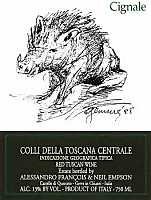
|
|
Cignale 2001 |
|
| Castello di Querceto (Tuscany, Italy) | |
| Grapes: Cabernet Sauvignon (90%), Merlot (10%) | |
| Price: € 47.00 | Score: |
| Cignale shows an intense ruby red color and nuances of garnet red, little transparency. The nose reveals intense, clean, pleasing, refined and elegant aromas which start with hints of black cherry, black currant and plum followed by aromas of violet, vanilla, tobacco, blueberry, licorice, chocolate, leather, cinnamon, tar and mace. The mouth has very good correspondence to the nose, a tannic attack and however balanced by alcohol, full body, intense flavors, agreeable. The finish is persistent with flavors of black cherry, plum and black currant. A well made wine. Cignale ages for 20-24 months in barrique followed by at least 6 months of aging in bottle. | |
| Food Match: Game, Roasted meat, Braised and stewed meat, Hard cheese | |
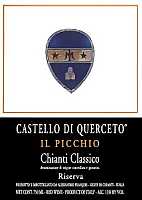
|
|
Chianti Classico Riserva Il Picchio 2001 |
|
| Castello di Querceto (Tuscany, Italy) | |
| Grapes: Sangiovese (92%), Canaiolo Nero (8%) | |
| Price: € 28.00 | Score: |
| The wine shows a brilliant ruby red color and nuances of garnet red, little transparency. The nose denotes intense, clean, pleasing, refined and elegant aromas which start with hints of plum, raspberry and black cherry followed by aromas of violet, vanilla, cyclamen, blueberry, tobacco, licorice, carob, pink pepper and menthol. The mouth has good correspondence to the nose, a tannic attack and however balanced by alcohol, full body, intense flavors, agreeable. The finish is persistent with flavors of plum, black cherry and raspberry. A well made wine. Chianti Classico Riserva Il Picchio ages for 12 months in barrique followed by at least 6 months of aging in bottle. | |
| Food Match: Roasted meat, Braised and stewed meat, Hard cheese | |
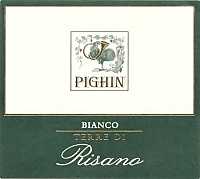
|
|
Friuli Grave Bianco Terre di Risano 2005 |
|
| Pighin (Friuli Venezia Giulia, Italy) | |
| Grapes: Tocai Friulano, Pinot Blanc, Sauvignon Blanc | |
| Price: € 12.00 | Score: |
| The wine shows a pale straw yellow color and nuances of greenish yellow, very transparent. The nose denotes intense, clean and pleasing aromas which start with hints of plum, peach and apple followed by aromas of hawthorn, broom, almond, pear and elder. The mouth has good correspondence to the nose, a crisp attack and however balanced by alcohol, good body, intense flavors, agreeable. The finish is persistent with flavors of peach, plum and almond. This wine ages in steel tanks. | |
| Food Match: Fried fish, Pasta and risotto with fish and crustaceans, Sauteed white meat | |
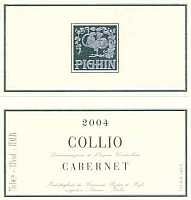
|
|
Collio Cabernet 2004 |
|
| Pighin (Friuli Venezia Giulia, Italy) | |
| Grapes: Cabernet Sauvignon (60%), Cabernet Franc (40%) | |
| Price: € 16.50 | Score: |
| The wine shows an intense ruby red color and nuances of ruby red, moderate transparency. The nose reveals intense, clean, pleasing and refined aromas which start with hints of black cherry and violet followed by aromas of blueberry, plum, bell pepper, vanilla and licorice. The mouth has good correspondence to the nose, a slightly tannic attack and however balanced by alcohol, good body, intense flavors. The finish is persistent with flavors of black cherry and plum. Collio Cabernet Ages for 14 months in cask. | |
| Food Match: Roasted meat, Braised and stewed meat, Hard cheese | |
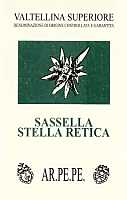
|
|
Valtellina Superiore Sassella Riserva Stella Retica 1998 |
|
| AR.PE.PE. (Lombardy, Italy) | |
| Grapes: Nebbiolo (Chiavennasca) | |
| Price: € 14.00 | Score: |
| The wine shows a brilliant brick red color and nuances of brick red, transparent. The nose reveals intense, clean, pleasing, refined and elegant aromas which start with hints of cherry, strawberry and raspberry followed by aromas of plum, dried violet, dried rose, vanilla, tobacco, licorice, leather, cocoa, truffle and mace. The mouth has good correspondence to the nose, a tannic attack and pleasing crispness, however balanced by alcohol, full body, intense flavors, pleasing roundness. The finish is persistent with flavors of cherry, raspberry and strawberry. A well made wine. This Valtellina Superiore Sassella Riserva ages for at least 2 years in cask followed by at least 6 months of aging in bottle. | |
| Food Match: Roasted meat, Stewed and braised meat, Hard cheese | |
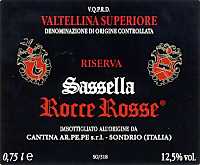
|
|
Valtellina Superiore Sassella Riserva Rocce Rosse 1996 |
|
| AR.PE.PE. (Lombardy, Italy) | |
| Grapes: Nebbiolo (Chiavennasca) (95%), Brugnola, Pinot Noir (5%) | |
| Price: € 23.00 | Score: |
| This wine shows a brilliant brick red color and nuances of brick red, transparent. The nose reveals intense, clean, pleasing, refined and elegant aromas that start with hints of strawberry, cherry and raspberry followed by aromas of plum, dried violet, dried rose, cyclamen, vanilla, tobacco, leather, licorice, cocoa, mace and menthol. The mouth has excellent correspondence to the nose, a tannic attack and pleasing crispness, however balanced by alcohol, full body, intense flavors, pleasing roundness. The finish is very persistent with long flavors of strawberry, cherry and raspberry. A well made wine. Valtellina Superiore Sassella Riserva Rocce Rosse ages for more than 4 years in cask. | |
| Food Match: Game, Roasted meat, Braised and stewed meat, Hard cheese | |
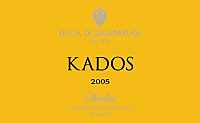
|
|
Kados 2005 |
|
| Duca di Salaparuta (Sicily, Italy) | |
| Grapes: Grillo | |
| Price: € 7.60 | Score: |
| Kados shows a brilliant greenish yellow color and nuances of greenish yellow, very transparent. The nose denotes intense, clean, pleasing and refined aromas which start with hints of pear and pineapple followed by aromas of hawthorn, almond, peach and vanilla. The mouth has good correspondence to the nose, a crisp attack and however balanced by alcohol, good body, intense flavors, agreeable. The finish is persistent with flavors of pear, apple and peach. Kados ferments in barrique and ages in cement tanks. | |
| Food Match: Fried fish, Pasta and risotto with fish and crustaceans, Broiled crustaceans | |
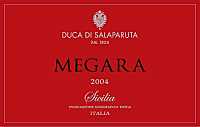
|
|
Megara 2004 |
|
| Duca di Salaparuta (Sicily, Italy) | |
| Grapes: Frappato (60%), Syrah (40%) | |
| Price: € 7.70 | Score: |
| The wine shows a brilliant ruby red color and nuances of ruby red, moderate transparency. The nose reveals intense, clean, pleasing and refined aromas which start with hints of cherry and raspberry followed by aromas of strawberry, plum, violet, rose and cyclamen. The mouth has good correspondence to the nose, a slightly tannic attack and pleasing roundness, however balanced by alcohol, good body, intense flavors. The finish is persistent with flavors of plum, cherry and raspberry. Megara ages for 12 months in cements tanks followed by 5-6 months of aging in bottle. | |
| Food Match: Stuffed pasta, Roasted fish, Stewed fish, Roasted white meat | |
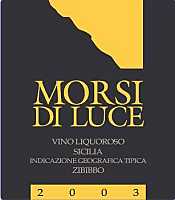
|
|
Morsi di Luce 2003 |
|
| Florio (Sicily, Italy) | |
| Grapes: Muscat of Alexandria (Zibibbo) | |
| Price: € 14.00 - 50cl | Score: |
| Morsi di Luce shows a brilliant amber yellow color and nuances of golden yellow, transparent. The nose denotes intense, clean, pleasing and refined aromas that start with hints of grape, orange marmalade and honey followed by aromas of apricot, peach, candied fruit, dried fig, quince jam, almond, litchi, sage and lavender. The mouth has good correspondence to the nose, a sweet and smooth attack, however balanced by alcohol, good body, intense flavors, agreeable. The finish is persistent with flavors of grape, orange marmalade and apricot. A well made wine. Morsi di Luce ages for 10 months in barrique followed by at least 10 months of aging in bottle. | |
| Food Match: Confectionery, Dried fruit tarts | |
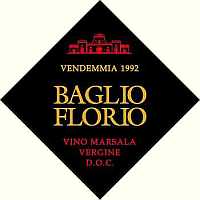
|
|
Marsala Vergine Baglio Florio 1992 |
|
| Florio (Sicily, Italy) | |
| Grapes: Grillo | |
| Price: € 18.00 - 50cl | Score: |
| Marsala Vergine Baglio Florio shows a brilliant amber yellow color and nuances of amber yellow, transparent. The nose reveals intense, clean, pleasing, refined and elegant aromas that start with hints of rancho, dried fig and almond followed by aromas of citrus fruit peel, ethereal, chestnut honey, licorice, ceder, walnut, vanilla and leather. The mouth has good correspondence to the nose, a pleasing crisp attack and good roundness, however balanced by alcohol, good body, intense flavors. The finish is persistent with flavors of almond, dried fig and walnut. A well made wine. This Marsala Vergine ages for more than 10 years in cask followed by at least 12 months of aging in bottle. | |
| Food Match: Hard cheese, Broiled fish, Roasted meat | |
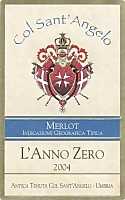
|
|
L'Anno Zero 2004 |
|
| Col Sant'Angelo (Umbria, Italy) | |
| Grapes: Merlot | |
| Price: € 12.00 | Score: |
| This wine shows a pale ruby red color and nuances of garnet red, moderate transparency. The nose denotes intense, clean and pleasing aromas which start with hints of black cherry, plum and black currant followed by aromas of blueberry, violet, carob and vanilla. The mouth has good correspondence to the nose, a slightly tannic attack and however balanced by alcohol, good body, intense flavors. The finish is persistent with flavors of black cherry and plum. L'Anno Zero ages for 6 months in cask, 3 months in steel tanks and 3 months in bottle. | |
| Food Match: Roasted white meat, Sauteed meat, Stuffed pasta | |
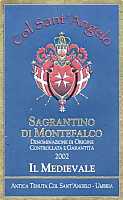
|
|
Sagrantino di Montefalco Il Medievale 2002 |
|
| Col Sant'Angelo (Umbria, Italy) | |
| Grapes: Sagrantino | |
| Price: € 18.00 | Score: |
| This Sagrantino di Montefalco shows a brilliant ruby red color and nuances of garnet red, moderate transparency. The nose denotes intense, clean and pleasing aromas which start with hints of black cherry, blackberry and plum followed by aromas of violet, vanilla, tobacco and carob. The mouth has good correspondence to the nose, a tannic attack and however balanced by alcohol, full body, intense flavors. The finish is persistent with flavors of blackberry and plum. This Sagrantino di Montefalco ages for 22 months in cask followed by 8 months of aging in bottle. | |
| Food Match: Roasted meat, Braised meat | |
Giorgio LungarottiThe recent history of wine in Umbria is indissolubly associated to Giorgio Lungarotti, a name who has contributed to the prestige's rebirth of the quality of Italian enology in the world |
|
The history of wine in Umbria, as well as the one in Italy, would not be same without the fundamental and tenacious contribution of one of the great names of wine of the green heart of Italy, indisputable patriarch of the recent development of wine making in Umbria and its success in the world: Giorgio Lungarotti. Umbria and its wines have today walked a long way, a journey which was probably unimaginable 40 years ago, which had among its protagonists a name in particular, one of the many pioneers who in the 1960s had the dream of making the wine of their lands great and to believe in the potentialities of their history and traditions. Giorgio Lungarotti was one of them, a man who had a strong passion for his land and for his region, who believed in the small green heart of Italy - Umbria - was possible to make great wines. All began in 1962 in Torgiano - today one of the most important places of excellence in Umbria for wine making - walking a way which will allow the pleasant Umbrian town to be recognized, in 1968 and among the first ones in Italy, the Denominazione d'Origine Controllata status (DOC, Denomination of Controlled Origin).
Among the protagonists of that first and important success, Rubesco - the historical Torgiano Rosso DOC red wine - which since 40 years still distinguishes Lungarotti winery in the world and one of the most famous Umbrian wines, to which side there is also the prestigious Torgiano Rosso Riserva Rubesco Vigna Monticchio red wine. In 1999, when Giorgio Lungarotti passed away, the management of the winery passed in the hands of his daughters, Chiara Lungarotti and Teresa Severini sisters, who together with Giorgio Lungarotti's wife, Mrs. Maria Grazia Marchetti Lungarotti, will start the new style of the winery, a management system completely run by women. Thanks to the teachings and the passion of the father Giorgio, Chiara Lungarotti and Teresa Severini continue today, with passion and determination, the history of this important Umbrian winery. New wines have been introduced - many of them are in fact the result of the intuition and the work of Teresa Severini - which completes the range of the historical wines of the winery, the robust red San Giorgio Rosso and the prestigious Torgiano Rosso Riserva Rubesco Vigna Monticchio. Two new wines characterizing the recent history of Lungarotti winery are in fact the result of the work of Teresa Severini, one of the first women wine makers in Italy and one of the founders of “Donne del Vino” association (Women of Wine). Aurente, an excellent white wine - a blend of Chardonnay and the local Grechetto - and Giubilante, an interesting red wine created by blending Merlot, Sangiovese and Syrah whose label was created by painter Piero Dorazio. These wines are now supported by the results of the Lungarotti winery's vineyards planted in the other great wine land of Umbria - Montefalco - famous in the world for its Sagrantino. This year has been in fact released in the market for the first time Lungarotti winery's Sagrantino di Montefalco, 5400 bottles of vintage 2003, an interesting result offering good hopes for future vintages, according to the premises, this wine will capable of giving wonderful emotions and satisfactions to the palates of wine lovers.
Chiara Lungarotti - recently elected president of Movimento Turismo del Vino - is the managing director of the winery. Thanks to her passion and competence in agricultural and wine making matters, she introduced modern and innovative systems to the vineyards and to the cellar, while paying attention to keep the balance between family traditions and the experimentation and innovative wine making models. Thanks to the cultural and artistic competence and sensibility of Mrs. Maria Grazia Marchetti Lungarotti, was established the Lungarotti Foundation, an important link between the world of art and wine of this family. Thanks to the work of Mrs. Maria Grazia Marchetti Lungarotti were also established the wine museum and the oil museum, two important and extraordinary witnesses of the culture and history of these two important products belonging to the Umbrian and Italian traditions. The museums, also thanks to the extraordinary historical findings which are kept here, are today two cultural sites of national importance and famous all over the world. The vineyards of Lungarotti winery are planted in the wine area of Torgiano, to which have recently added the ones in Montefalco. The vineyards in Torgiano are planted in hilly lands. The grapes used for the production of red reserve wines and the most prestigious whites come from vineyards planted at altitudes from 270 and 300 meters (880-985 feet), whereas the grapes used for the production of young and crisp wines come from vineyards planted in the Tiber valley, at altitudes from 170 and 200 meters (550-655 feet). Lungarotti winery's vineyards are cultivated in respect to nature and according to eco-compatible principles, however using - when necessary - modern viticultural technologies. Including the interesting system for meteorological control provided by five specific stations placed in the vineyards and which provide precious information about the local conditions, therefore allowing a proper planning of practices according to the meteorological conditions, ensuring a better agricultural management while limiting to the minimum antiparasite interventions. In the cellar are also found the most innovative wine making technologies and, despite there also are oak barriques, the Lungarotti style has always preferred the use of large French oak casks, in particular, for wines produced with Sangiovese grape. In the caves used for aging wines, there are also found suggestive rows of pupitres used for the production of the classic method sparkling wine Lungarotti Brut. A characteristic which has always distinguished Lungarotti reserves, is the long aging in bottle, today however reduced to five years. Of remarkable competence is the team of wine makers who bring Lungarotti wines to life. Besides Teresa Severini, the team of wine makers at Lungarotti is supported by the work of Vincenzo Pepe as well as two external consultants of great prestige, Lorenzo Landi and Denis Dubourdieu, wine maker and researcher of worldwide fame, as well as professor of enology in the prestigious faculty of enology at the University of Bordeaux.
|
||||||||||||||||||||
|
Score legend Prices are to be considered as indicative. Prices may vary according to the country or the shop where wines are bought |
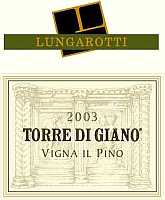
|
|
Torre di Giano Bianco Vigna il Pino 2004 |
|
| Lungarotti (Umbria, Italy) | |
| Grapes: Trebbiano Toscano (70%), Grechetto (30%) | |
| Price: € 9.75 | Score: |
| The wine shows a pale straw yellow color and nuances of greenish yellow, very transparent. The nose reveals intense, clean, pleasing and refined aromas that start with hints of pear, apple and hawthorn followed by aromas of pineapple, broom, vanilla, hazelnut and plum. The mouth has good correspondence to the nose, a crisp attack and however balanced by alcohol, good body, intense flavors, pleasing roundness. The finish is persistent with flavors of apple, plum and pear. A part of Torre di Giano Vigna Il Pino ferments and ages for 3 months in barrique, followed by 6 months of aging in bottle. | |
| Food Match: Stuffed pasta, Roasted fish, Broiled crustaceans, Roasted white meat | |

|
|
Aurente 2004 |
|
| Lungarotti (Umbria, Italy) | |
| Grapes: Chardonnay (90%), Grechetto (10%) | |
| Price: € 14.85 | Score: |
| Aurente shows an intense golden yellow color and nuances of golden yellow, very transparent. The nose reveals intense, clean, pleasing and refined aromas which start with hints of banana, toasted and hazelnut followed by aromas of apple, plum, yeast, vanilla, pineapple, litchi, grapefruit, mineral and praline. The mouth has good correspondence to the nose, a crisp attack and pleasing roundness, however well balanced by alcohol, good body, intense flavors, agreeable. The finish is persistent with flavors of banana, plum and grapefruit. A well made wine. Aurente ages for 7 months in barrique followed by 6 months of aging in bottle. | |
| Food Match: Stuffed pasta, Roasted fish, White roasted meat, Fish and mushrooms soups | |
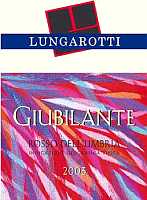
|
|
Giubilante 2003 |
|
| Lungarotti (Umbria, Italy) | |
| Grapes: Sangiovese, Merlot, Syrah | |
| Price: € 8.85 | Score: |
| Giubilante shows an intense ruby red color and nuances of ruby red, moderate transparency. The nose denotes intense, clean, pleasing and refined aromas which start with hints of black cherry, plum and black currant followed by aromas of blueberry, vanilla, violet, carob and black pepper. The mouth has good correspondence to the nose, a slightly tannic attack and pleasing roundness, however balanced by alcohol, good body, intense flavors, agreeable. The finish is persistent with flavors of black cherry and plum. Giubilante ages for 8 months in barrique followed by one year of aging in bottle. | |
| Food Match: Broiled meat and barbecue, Roasted meat, Stewed meat with mushrooms | |
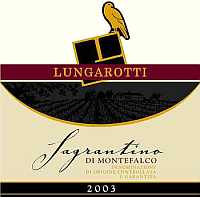
|
|
Sagrantino di Montefalco 2003 |
|
| Lungarotti (Umbria, Italy) | |
| Grapes: Sagrantino | |
| Price: € 17.25 | Score: |
| The wine shows a brilliant ruby red color and nuances of garnet red, little transparency. The nose reveals intense, clean, pleasing and refined aromas which start with hints of plum, blackberry and black cherry followed by aromas of blueberry, violet, vanilla, carob, anise, mace and clove. The mouth has good correspondence to the nose, a tannic attack and however balanced by alcohol, full body, intense flavors. The finish is persistent with flavors of plum, black cherry and blackberry. This Sagrantino di Montefalco ages in barrique for 12 months followed by 18 months of aging in bottle. | |
| Food Match: Roasted meat, Game, Braised and stewed meat, Hard cheese | |
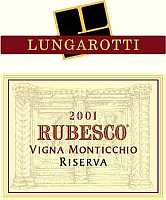
|
|
Torgiano Rosso Riserva Rubesco Vigna Monticchio 2001 |
|
| Lungarotti (Umbria, Italy) | |
| Grapes: Sangiovese (70%), Canaiolo Nero (30%) | |
| Price: € 20.00 | Score: |
| This wine shows a brilliant ruby red color and nuances of garnet red, little transparency. The nose reveals intense, clean, pleasing, refined and elegant aromas which start with hints of black cherry, plum and blueberry followed by aromas of violet, cyclamen, vanilla, raspberry, blackberry, carob, licorice, tobacco, cinnamon and menthol. The mouth has good correspondence to the nose, a tannic attack and pleasing roundness, however balanced by alcohol, full body, intense flavors, agreeable. The finish is persistent with flavors of black cherry, plum and blackberry. A well made wine. Torgiano Rosso Riserva Rubesco Vigna Monticchio ages in cask and in barrique for 12 months followed by 3 years of aging in bottle. | |
| Food Match: Roasted meat, Braised and stewed meat, Hard cheese | |

|
|
San Giorgio 2001 |
|
| Lungarotti (Umbria, Italy) | |
| Grapes: Cabernet Sauvignon (50%), Sangiovese (40%), Canaiolo Nero (10%) | |
| Price: € 17.25 | Score: |
| San Giorgio shows an intense ruby red color and nuances of garnet red, little transparency. The nose reveals intense, clean, pleasing, refined and elegant aromas which start with hints of black currant, black cherry and plum followed by aromas of violet, vanilla, blueberry, blackberry, menthol, tobacco, licorice, chocolate, cinnamon and pink pepper. The mouth had very good correspondence to the nose, a tannic attack and however well balanced by alcohol, full body, intense flavors, agreeable. The finish is very persistent with long flavors of black cherry, black currant and plum. A well made wine. San Giorgio ages for 12 months in barrique followed by 3 years of aging in bottle. | |
| Food Match: Roasted meat, Game, Braised and stewed meat, Hard cheese | |
| Cantine Giorgio Lungarotti - Via Mario Angeloni, 16 - 06089 Torgiano, Perugia (Italy) - Tel. +39 75 988661 Fax +39 75 9886650 - Winemaker: Vincenzo Pepe with the support of Denis Dubourdieu and Lorenzo Landi - Established: 1962 - Production: 2.600.000 bottles - E-Mail: lungarotti@lungarotti.it - WEB: www.lungarotti.it |
Cellar Journal |
|
This section is reserved to wine producers who want to publish news and information about their business, to announce new products or just for communicating to customers information and promotions about their products and activity. Send news to be published to our e-mail address.
|
News |
|
In this section are published news and information about events concerning the world of wine and food. Whoever is interested in publishing this kind of information can send us a mail to our address.
|
Italian Cooking and WineAmong the most famous and rich ones of the world, Italian cooking exalts the simplicity of ingredients in a triumph of flavors in which wine is always an excellent companion of the table |
|
Talking about Italian cooking is not easy. The richness and vastness of this tasty gastronomy is such as to practically make incomplete every definition or description. Among the most famous and appreciated cooking of the world, Italian gastronomy - an immense heritage result of the culinary cultures and traditions of its regions, as a matter of fact, each representing a world on its own - benefits of the richness and diversity of the ingredients which typically distinguish every area of the boot: sea, mountains, hills, lakes and plains. It certainly is also the result of cultures which have had a particular sensibility for food, not only a way to ensure survival in its essential form, but also a way to get pleasure from the things the land could offer. Simple ingredients but however having an invaluable richness and with which it is possible to make refined dishes, such as pasta and its endless ways to dress it, and pizza.
Italian cooking can be defined as a group of local and regional gastronomical cultures and traditions that - thanks to the common use of many ingredients - have contributed to create a model and a style identifiable as “Italian cooking”. The gastronomical cultures of every region has also undergone the influence of ancient people who lived there in ancient times and who introduced both the use of many ingredients as well as techniques and specific dishes, which have become with time both typical and identifying. Good examples are offered by the importance of cereals and legumes in the regions in which lived Etruscans - in particular Umbria and Tuscany - or by the strong influence of Arab gastronomical culture in Sicily, as well as the influence of French cooking in the North-Western regions of Italy. Besides that, it was finally added the indispensable “ingredient” represented by history, which in the course of time has improved - as well as completely removed - the use of ingredients, cooking techniques and taste. Among the many ingredients characterizing Italian cooking, there is also wine that, not only it was - and still is - always present in the table as a companion to the meals, it is frequently an essential ingredient in the preparation of dishes and sauces or for marinading some ingredients before cooking. Wine has always played a very important role in Italian cooking, a role which is of course shared with other and fundamental ingredients, such as olive oil and pasta. Thanks to the diversity of the territory and the richness of the resources found in every region, Italian cooking offers an extremely vast gastronomical repertoire, from land cooking - expressed by the richness of vegetables, cereals and legumes - to fish cooking, from the endless culture of bread and buns, of which the most famous son certainly is pizza, and the imaginative and tasty pastry cooking. A gastronomical style appreciated not only in Italy, but also the synonym of “tasty eating” all over the world.
|
||||||||
|
Among the many ingredients which have made Italian cooking famous and appreciated in the world, a place of honor certainly goes to pasta. Short, long, in its countless and almost impossible shapes, pasta is an ingredient which is present in countless and practically endless recipes. The type of pasta which mainly identifies Italian cooking is spaghetti, traditionally prepared with durum wheat flour. The type of flour used for making pasta also distinguishes the area and the region of origin: durum wheat flour in southern regions; plain wheat flour for central and northern regions. Traditionally, in northern and central regions of Italy, plain wheat flour is worked with eggs, sometimes, in some region of central Italy, with water only. In southern regions, durum wheat flour is typically worked with water. In Italy pasta is also produced with flour obtained by other cereals, such as spelt and barley, as well as flour obtained by legumes: famous is the pasta made with chickpea flour. In Valtellina - a mountain area in northern Italy - are famous the typical pizzoccheri, a kind of pasta shaped in short ribbons and produced with buckwheat flour. In the preparation of the so called main courses, despite it indisputable dominion in the table of Italians, pasta is not the only ingredient used for this purpose. In fact, in Italy cereals are widely used as well, in particular rice - typically cultivated in the northern regions - with which, thanks to its extreme versatility in the cooking, is the protagonist of many recipes, including the famous risotto and its endless interpretations. Typical of the regions of central Italy are the other cereals and legumes, in particular Umbria and Tuscany, where spelt, barley, wheat, lentils, chickpeas, beans, broadbeans and chickling vetch (grass pea) are the absolute protagonists of tasty soups: a very ancient tradition of Etruscan times. The recipes of Italian cooking, thanks to the richness of the products of the land, make a wide use of vegetables of any kind, including the vegetables which were introduced in Italy from America centuries ago - bell peppers, tomatoes and potatoes - they are so widely used as to be now considered as “typical”. A classic example is tomato, an ingredient which is directly associated to pasta and with which are being prepared tasty sauces used for its dressing. Talking about the use of vegetables in pasta sauces - as well as for some meat recipes - three of them are to be considered the base for most of them: onion, carrot and celery. These three vegetables, properly minced or grossly cut, added to olive oil and allowed to sauté, represent the base for countless dishes and sauces. Vegetables are also used for the preparation of specific dishes, in which their role is of primary importance. A complete list of vegetables used in Italian cooking would be however incomplete because of the tens of varieties used, to which are also added the typical vegetables of each region. Among the most typical ones are mentioned eggplant, potato, cabbage, cauliflower, broccoli, pumpkin, cucumber, tomato, spinach, onion, turnips and beets. Dishes of Italian cooking are richly aromatized and flavored by aromatic herbs such as rosemary, sage, fennel, basil, parsley, garlic, mint, thyme, marjoram and oregano. Also the use of spices is pretty common: pepper, cinnamon, nutmeg and saffron the most typical ones. Not only from the garden the fantasy of cooks take its ingredients. The woods are in fact another important resource of Italian cooking and from which are being harvested mushrooms, asparaguses and countless wild herbs, as well as berries and fruits which, in past times more than in recent ones, were used in the preparation of many recipes, in particular dishes based on meat, a very common tradition, for example, at the time of Etruscans, who were also used to add honey. Meat is mainly used in the cooking of the internal areas, the ones far from sea coasts and lakes. The most common meats in Italian cooking are bovine, pork and ovine, as well as poultry. In particular, with pork and boar meat are being prepared many cold cuts, which are also ingredients of many dishes as well as making a food on their own typically served with bread or buns. In mountain and hilly regions, it is also common the consumption of game, in particular boar, venison, deer, rose and wild birds. Thanks to the long coastline, the regions bordering the sea count in their gastronomies a rich selection of recipes based on fish. The varieties of fish used for the preparation of dishes changes from region to region, as each of them prefers specific fishes also according to the species mainly present in their seas. The presence of lakes and rivers in the Italian territory allows the regions far from the sea to bring fish on the table, as well as dry fishes kept in salt, such as cod and stockfish. As for condiments, the main role is played by olive oil, generally used raw or as a base ingredient for cooking, present in every region of Italy thanks to the remarkable presence of olive trees. Despite olive oil represents the main condiment in every area of Italy, in the northern regions of Italy is also used butter, a characteristic almost unknown in central and southern regions. Among fats used in cooking, an important role is played by pork lard, which is also used for frying.
|
||||
|
The richness of Italian cooking is such that any attempt to provide a complete list of the recipes is certainly presumptuous. The richness of the many folk cultures that in every region are still strong associated to the traditions of the past, including the culinary ones, make practically impossible the definition of “Italian cooking”. It can be however defined a “national” style universally recognized as the interpretation of cooking in order to make dishes in a way which can be identified as “Italian”. This aspect can be better understood with one of the most common ingredients of Italian cooking: pasta. The most typical and common way to cook pasta in Italy - both fresh and dried - is to boil it al dente and therefore to pour it on part of the sauce, mix and then add the remaining sauce. Another typical way for cooking pasta in Italy is to stuff it with meat or vegetable fillings, therefore boil it as usual, or to cook it in the oven by enriching the recipe with more or less complicated and tasty sauces. Another characteristic of Italian cooking is the way with which it is prepared a particular recipe in which rice is the absolute protagonist: risotto. This tasty recipe - all Italian - provides for the slow and progressive stewing of rice in a liquid, generally broth, to which are added the ingredients suggested by fantasy. As for meat, in Italy it is prepared by using many techniques: roasting, broiling, braising, stewing and sauteing, techniques which are also used for fish. Before being cooked, meat and fish can also be marinated in wine or vinegar, to which are added spices and vegetables. Among “main courses”, soups are very common, generally served in place of pasta, or as it would be properly called, in place of pastasciutta. The soups of Italian cooking are made with all of its typical ingredients, in particular cereals and legumes, most of the times enriched with meat. A particular mention should go to bread and its countless derivatives, including pizza with its endless variants always offering a special and tasty meal distinguishing Italy, its culture and cooking, everywhere in the world, Italy.
|
|
In Italy it is believed the matching of wine with dishes must follow the concept of regionality, that is the food of a specific region is to be matched with the wines of the same territory. This principle - which obeys to a traditional rule only - does not have any technical conformation. Thanks to the richness of wines and grapes found in every region, it is very likely that one or more wines of a region can be matched to the dishes of the same land. This rule, which is frequently used in Italy, should not be considered as mandatory or absolute, as it is possible to create excellent enogastronomical matching also with the wines of other regions that - in many cases - are even more harmonic that the ones made with the wines of the same region. In fact, it should be remembered a correct enogastronomical matching is always formulated according to the organoleptic qualities both of the dish and wine, no matter the region they are from. For example, saying that pasta or risotto must be always matched with a white wine, is a rule having no technical confirmation, as it is not rare the matching with other style of wines, including red. The main factor for the matching with pasta is represented by the sauce, therefore a rich and robust meat sauce can be matched to a red wine having the same relative structure. The same rule is valid for fish as well - generally considered the ideal companion of white wines - which can be well matched to a red wine. On this regard it can be considered the famous and rich livornese fish soup cacciucco, being so complex as to make most of the white wines anonymous. The same considerations are also valid for recipes based on meat, in which will be evaluated the type of meat, cooking technique and condiments. A subject on its own is pizza. Despite in Italy it is frequent the matching with beer, this famous and tasty recipe is excellently matched to wine, the way suggested by tradition. Also in this case it must be considered the ingredients used as condiments, including the base that, as it is made with flour, its basically sweet taste will tend to prevail over the condiments. This characteristic suggests the use of a slightly sparkling or sparkling wine, including a classic method one, which will not disappoint the palate of connoisseurs.
|
Citrus FruitsPerfumed and delicious, citrus fruits are common in all the Mediterranean area, known and used for centuries both as a food and for the production of cosmetics |
|
Citrus fruits belong to the family of Rutaceae, subfamily Aurantioideae. The family of citrus fruits is made of three genuses: Citrus, Fortunella and Poncirus Trifoliata. Despite the genus of citrus fruits is made of three genders only and eighteen defined species, there are many natural mutations. For this reason citrus fruits are very common in the world, with which have also been created many hybrids. According to a botanical point of view, the fruit is a hesperidium, that is a berry with a pulp divided in segments containing seeds. The pulp of citrus fruits contain cellulose, whereas the juice contains carbohydrates, citric and tartaric acid, proteins, ashes, vitamin C, lipids, carotenoids and chlorophyll.
|
|
The homeland of the Citrus genus is China and India, Poncirus is from Korea and China, whereas Fortunella is from China. China and other neighboring regions are the territories from which citrus fruits have been originated, it is right in these regions we can find the first written evidences about citrus fruits. From the far east, citrus fruits begin to spread in the neighboring countries and arrive to India, Indochina and the islands of Southern Chinese Sea, the Philippines sea and the Indian ocean. From China citrus fruits also arrive to Japan: the modern satsuma mandarin, making 80% of this country's production, derives from Chinese guanxi. It seems this mandarin has been imported in Japan in 1500 and it quickly adapted to the new soil therefore becoming a typical product. The first written information about citrus fruits in India dates back to the times of the first written forms of Sanskrit, the Indo-European language imported from Aryans between 2000 and 1000 BC. In Sanskrit, citron and lemon are translated with the same word jambila: this term is found for the first time in the Vajasaneyi samhita, written around 800 BC. As in Sanskrit do not exist ancient words to refer to orange, this support the hypothesis it was imported in India from China about 2000 years ago, probably by the migrations from Yunnan to the Brahmaputra valley. It is known people from India had cultural and commercial contacts with the people of Mesopotamia, the land between the Tigris and Euphrates rivers. Despite the climate was not suited for the cultivation of citrus fruits, the skill of Mesopotamian agriculturists was successful in overcoming this limitation.
It is very likely the cultivation of citrus fruits made its way from India to Afghanistan and Pakistan, from here it spread in the west. Another evidence of the “migration” of citrus fruits to the west is offered by Jewish sacred books: the frequency with which the citron plant is mentioned suggests the Jews knew citrus fruits, or at least citron, before the Christian era. In Greece the citron plant is mentioned in many documents. In some papyri citron is mentioned with the word kitron, in other documents of the sixth century, such as the ones of Galen, it is used the term kitrion or kitreos. Theophrastus (372-287 BC) in his book “Historia plantarum”, describes the citron plant by specifying it was a plant common in Persia and in the land of Media. Another evidence is found in a book dated back to 200 AD, “Deipnosophistae” written by Athenaeus, in which it is said Juba, king of Mauritania, in his “History of Libya” mentioned this fruit and said it was called “Esperya apple” by Libyans. According to these evidences, it seems Greeks did not know any citrus fruits but citron, although the expedition of Alexander reached Punjab (India) and botanists also took part to the expeditions. Ancient Romans called citron malus medica first, then citrus. The first mention in Latin literature dates back to the second century BC by Cloanzio Vero, followed one century later by botanist Opium who mentioned it in its book “de Silvestris Arboribus”. Theocritus from Syracuse, who lived in the second century BC, did not mention it. In the Middle Age, during the first crusades, French saw for the first time citrus fruits and therefore introduced them in their homeland. Also the maritime republics contributed to the spreading of citrus fruits. In the twelfth, thirteenth and fourteenth centuries citrus fruits were common all over Italy, Spain and South France. It is believed sweet orange was not introduced in Europe by Arabs or by maritime republics: it probably were Portuguese to introduce it in the Old Continent. In fact, one of the first names used for sweet orange was “Portugal”. During Renaissance citrus fruits were spread and known everywhere: this is also proven by the many written documents, as well as being depicted in many paintings. In Italy the best climate for the cultivation of citrus fruits is in the south. In central and northern regions became common the custom of planting them in earthenware vases, which could be exposed to the sun during summertime and during wintertime moved in a place sheltered from the cold. This technique of cultivating citrus fruits also spread in France, and it was then adopted by Germans, Belgians and Dutch as well. At the end of 1700s citrus fruits were known in America too, introduced by Europeans during the colonization of the continent. As time passed by, new varieties of citrus fruits were discovered, including bergamot, grapefruit and Mediterranean mandarin, clementine and tangerine. In particular, bergamot was probably originated by a spontaneous hybridization, whereas grapefruit was discovered in the Barbados Island and was described in 1750 by Griffiths Hughes, whereas in 1789 Patrick Browne described the grapefruit discovered in Jamaica, and both them called it the “forbidden fruit”.
|
||||||||||||
|
The family of citrus fruits is vast and includes tens of varieties, many of them are used for nutritional purposes as well as in the cosmetic industry, others, which are not considered edible, are used by the cosmetic industry only because of their essential oils. Following is a list of the most important citrus fruits varieties, their use and properties.
Arabs discovered the extraction technique for essential oils, however the industrial production of perfumes with extracts of the skin of fruits and petals of flowers was invented by Italians. Naples and Sicily developed these techniques and from here started the fashion of exotic perfumes, which then spread all over Europe. According to a nutritional and dietetic point of view, citrus fruits have a fundamental importance in the diet of the Mediterranean area which is also the main area of production and consumption. In order to get the maximum benefits from citrus fruits juices, it is always advisable to consume them soon after their preparation, because vitamin C, when in contact with oxygen, light and heat, gets rapidly spoiled.
|
AquavitaeReview of Grappa, Distillates and Brandy |
|
|
| Distillates are rated according to DiWineTaste's evaluation method. Please see score legend in the "Wines of the Month" section. |
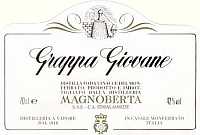
|
|
Grappa Giovane |
|
| Magnoberta (Piedmont, Italy) | |
| Raw matter: Pomace of Barbera, Freisa and Grignolino | |
| Price: € 13.50 - 70cl | Score: |
| This grappa is colorless, limpid and crystalline. The nose denotes intense, clean and pleasing of cherry, raspberry, plum and hazelnut with a slight perception of alcohol pungency. In the mouth has intense flavors with perceptible alcohol pungency which tends to dissolve rapidly, balanced sweetness, intense flavors, good roundness. The finish is persistent with flavors of apple and hazelnut. This grappa is produced with a discontinuous alembic still operating at low pressure. Alcohol 42%. | |

|
|
Grappa di Grignolino 1999 |
|
| Casa Luparia (Piedmont, Italy) | |
| Raw matter: Pomace of Grignolino | |
| Price: € 13.50 - 70cl | Score: |
| This grappa is colorless, limpid and crystalline. The nose reveals intense, clean, pleasing and refined aromas of cherry, raspberry, strawberry, cyclamen, rose and plum with almost imperceptible alcohol pungency. In the mouth has intense and pleasing flavors with perceptible alcohol pungency which tends to dissolve rapidly, balanced sweetness, agreeable. The finish is persistent with flavors of raspberry and strawberry. This grappa is produced with a discontinuous alembic still operating at low pressure. Alcohol 42%. | |

|
|
Grappa di Moscato Rosa 2004 |
|
| Zeni (Trentino, Italy) | |
| Raw matter: Pomace of Pink Muscat | |
| Price: € 25,00 - 70cl | Score: |
| This grappa is colorless, limpid and crystalline. The nose reveals intense, clean, pleasing and refined aromas of grape, rose, strawberry, cherry, raspberry and cyclamen with almost imperceptible alcohol pungency. In the mouth has intense and pleasing flavors with perceptible alcohol pungency which tends to dissolve rapidly, balanced sweetness, pleasing smoothness. The finish is persistent with flavors of strawberry, raspberry and grape. This grappa is distilled with a discontinuous bainmarie alembic still. Alcohol 40%. | |
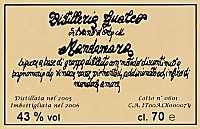
|
|
Mandamara 2005 |
|
| Distilleria Gualco (Piedmont, Italy) | |
| Raw matter: Grappa of Dolcetto and Barbera, Bitter Almond | |
| Price: € 19.50 - 70cl | Score: |
| Mandamara shows a pale amber yellow color, limpid and crystalline. The nose denotes intense, clean, pleasing and refined aromas of bitter almond, honey, vanilla and plum with almost imperceptible alcohol pungency. In the mouth is sweet with intense flavor and perceptible alcohol pungency which tends to dissolve rapidly, pleasing roundness. The finish is persistent with flavors of almond and honey. Mandamara is produced by the maceration of bitter almond in grappa of Dolcetto and Barbera. Alcohol 43%. | |
Wine Parade |
|
|
| The best 15 wines according to DiWineTaste's readers. To express your best three wines send us an E-mail or fill in the form available at our WEB site. |
| Rank | Wine, Producer | |
|---|---|---|
| 1 |
| Brunello di Montalcino 1999, Castello Banfi (Italy) |
| 2 |
| Amarone della Valpolicella Classico 2000, Zenato (Italy) |
| 3 |
| Colli Orientali del Friuli Rosazzo Bianco Terre Alte 2002, Livio Felluga (Italy) |
| 4 |
| Wine Obsession 2001, Vignamaggio (Italy) |
| 5 |
| Notarpanaro 1999, Taurino (Italy) |
| 6 |
| Chianti Classico Riserva Novecento 2000, Dievole (Italy) |
| 7 |
| Trento Talento Brut Riserva Methius 1998, Dorigati (Italy) |
| 8 |
| Riesling Central Otago 2004, Felton Road (New Zealand) |
| 9 |
| Nero al Tondo 2001, Ruffino (Italy) |
| 10 |
| Chianti Classico Riserva Novecento 2000, Dievole (Italy) |
| 11 |
| Don Antonio 2003, Morgante (Italy) |
| 12 |
| Amarone della Valpolicella Classico 1998, Santa Sofia (Italy) |
| 13 |
| Amarone della Valpolicella Classico Costasera 2001, Masi (Italy) |
| 14 |
| Soave Classico Monte Alto 2004, Ca' Rugate (Italy) |
| 15 |
| Sagrantino di Montefalco Collepiano 2003, Arnaldo Caprai (Italy) |
| |||||||
Privacy Policy | |||||||


| Copyright © 2002-2024 Antonello Biancalana, DiWineTaste - All rights reserved |
| All rights reserved under international copyright conventions. No part of this publication and of this WEB site may be
reproduced or utilized in any form or by any means, electronic or mechanical, without permission in writing from DiWineTaste. |